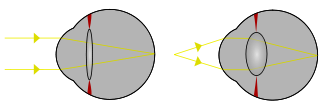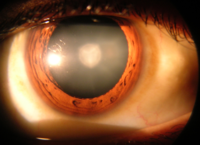Lens (anatomy)
2007 Schools Wikipedia Selection. Related subjects: Health and medicine
The lens or crystalline lens is a transparent, biconvex structure in the eye that, along with the cornea, helps to refract light to focus on the retina. Its function is thus similar to a man-made optical lens.
In humans, the refractive power of the lens in its natural environment is approximately 15 dioptres, roughly one-fourth of the eye's total power.
The lens is flexible and its curvature is controlled by ciliary muscles through the Zonules. By changing the curvature of the lens, one can focus the eye on objects at different distances from it. This process is called accommodation. The lens continually grows throughout life, laying new cells over the old cells resulting in a stiffer lens. The lens gradually loses its accommodation ability as the individual ages, the loss of the individual's focussing ability is termed Presbyopia.
The lens is made of transparent proteins called crystallins. The average concentration of lens proteins is about twice than that of other intracellular proteins and is thought to play a structural role in the lens. It is about 5 mm thick and has a diameter of about 9 mm for an adult human (though these figures can vary). The proteins are arranged in approximately 20,000 thin concentric layers, with a refractive index (for visible wavelengths) varying from approximately 1.406 in the central layers down to 1.386 in less dense cortex of the lens. This index gradient enhances the optical power of the lens. The lens is included into the capsular bag, maintained by the zonules of Zinn.
During the fetal stage, the development of the lens is aided by the hyaloid artery. In adults, the lens depends entirely upon the aqueous and vitreous humors for nourishment.
Diseases
- A cataract is an opacification of the normally transparent crystalline lens that leads to blurred vision.
- Ectopia lentis is a displacement or malposition of the lens from its normal location.
- Nuclear sclerosis is a normal age-related change of the centre of the lens, most commonly seen in dogs.

